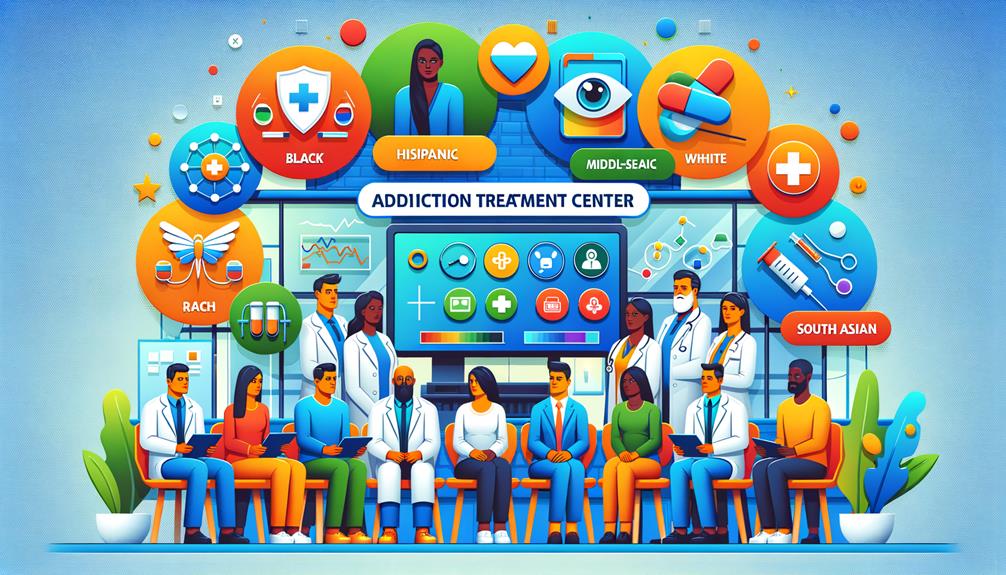Are you looking to enhance the effectiveness of addiction treatment centers? One effective strategy to consider is implementing prescription drug monitoring programs. By integrating these programs into treatment centers, you can maximize patient care and improve outcomes.
But how exactly does prescription drug monitoring work, and what benefits does it bring? In this discussion, we will explore the various ways in which prescription drug monitoring can be utilized to optimize addiction treatment centers, from improving patient care to overcoming implementation challenges.
So, let's dive into this topic and discover the potential of prescription drug monitoring in maximizing addiction treatment centers.
Benefits of Prescription Drug Monitoring Programs

Prescription drug monitoring programs provide invaluable benefits, helping to address the growing concern of prescription drug addiction and ensuring the safety and well-being of individuals. As a healthcare provider, your role in prescription drug monitoring is crucial in safeguarding public health. By actively participating in these programs, you become an integral part of the solution in combating prescription drug abuse.
As a knowledgeable healthcare provider, you understand the impact prescription drug monitoring can have on public health. These programs allow you to track and monitor prescription drug use, identifying potential cases of overuse, misuse, or doctor shopping. By having access to a patient's prescription history, you can make more informed decisions when prescribing medications and prevent potential harm. This not only protects the individual but also contributes to the overall well-being of your community.
Prescription drug monitoring programs also serve as a valuable tool in identifying and addressing addiction. By monitoring prescription drug use, you can identify patterns or signs of dependence, allowing for early intervention and treatment. This proactive approach can prevent individuals from falling into the vicious cycle of addiction and improve their chances of recovery.
Integration of Prescription Drug Monitoring in Treatment Centers
Integrating prescription drug monitoring into treatment centers is a crucial step in providing comprehensive care and support for individuals struggling with addiction. By incorporating this monitoring system, treatment centers can better understand the medication history of their patients and identify potential risks or patterns of misuse. However, there are certain integration challenges that need to be addressed.
One of the main challenges is the implementation of a robust and user-friendly electronic health record (EHR) system that can efficiently capture and analyze prescription drug data. Treatment centers need to invest in EHR systems that are compatible with prescription drug monitoring programs (PDMPs) and allow seamless integration of data. This will enable healthcare providers to access real-time information about their patients' medication history and make informed decisions about their treatment plans.
Another challenge is ensuring that treatment center staff are trained on how to effectively use and interpret the data provided by the PDMPs. It's important for healthcare providers to understand how to navigate the system, interpret the data, and use it to inform their treatment decisions. This requires ongoing training and education to keep up with evolving policies and best practices.
Despite these integration challenges, the benefits of incorporating prescription drug monitoring into treatment centers are significant. Monitoring outcomes through PDMPs can help identify potential drug interactions, prevent medication misuse, and improve treatment outcomes. By closely monitoring prescription drug use, treatment centers can provide more personalized and effective care, reducing the risk of relapse and promoting long-term recovery.
Enhancing Patient Care Through Prescription Drug Monitoring

Now let's explore how prescription drug monitoring can greatly enhance the level of care and support provided to patients struggling with addiction. By implementing a comprehensive prescription drug monitoring program, addiction treatment centers can significantly improve outcomes and reduce the risk of relapse for their patients.
Prescription drug monitoring allows healthcare providers to track and monitor the medications prescribed to patients with addiction issues. This monitoring system provides valuable information about a patient's medication history, including any controlled substances or potential drug interactions. With this knowledge, healthcare providers can develop personalized treatment plans that are tailored to each patient's specific needs.
By closely monitoring a patient's medication regimen, healthcare providers can identify any potential red flags, such as doctor shopping or misuse of medications. This proactive approach allows for early intervention and adjustments to the treatment plan, which can greatly improve outcomes and reduce the risk of relapse.
Additionally, prescription drug monitoring can help healthcare providers identify any potential gaps in care or areas where additional support may be needed. By having a complete picture of a patient's medication history and usage patterns, healthcare providers can ensure that patients receive the necessary medications and therapies to support their recovery journey.
Implementing a Successful Prescription Drug Monitoring System
To successfully implement a prescription drug monitoring system, it's crucial to establish clear protocols and guidelines that prioritize patient safety and effective addiction treatment. Effective implementation strategies for prescription drug monitoring are essential to ensure the system works seamlessly and achieves its intended goals.
One strategy is to involve key stakeholders, such as healthcare providers, pharmacists, and policymakers, in the development and implementation process. This collaboration will help identify potential challenges and tailor the system to meet the specific needs of addiction treatment centers.
Another important aspect of implementing a successful prescription drug monitoring system is ensuring privacy and confidentiality. Patients must feel confident that their personal information will be protected and used only for legitimate purposes. Implementing strong security measures, such as encryption and access controls, can help safeguard sensitive data. It's also crucial to train healthcare professionals on the importance of maintaining patient privacy and confidentiality.
Regular audits and evaluations should be conducted to assess the effectiveness of the prescription drug monitoring system. This will help identify any areas for improvement and ensure that the system continues to meet the evolving needs of addiction treatment centers.
Overcoming Challenges in Prescription Drug Monitoring for Treatment Centers

As addiction treatment centers strive to implement successful prescription drug monitoring systems, they must navigate and overcome various challenges that arise along the way. One of the major challenges is data integration. Treatment centers often have multiple systems and databases that store patient information, making it difficult to consolidate and integrate data from different sources. This can lead to gaps in information and hinder the effectiveness of prescription drug monitoring programs. However, with the advancement of technology and the availability of interoperable systems, treatment centers can now overcome this challenge by implementing integrated software solutions that allow for seamless data sharing and analysis.
Another challenge that treatment centers face is privacy concerns. While prescription drug monitoring is crucial for effective addiction treatment, it must be balanced with patient privacy rights. Treatment centers must ensure that patient information is securely stored and accessed only by authorized personnel. Implementing strong data security measures, such as encryption and access controls, can help alleviate privacy concerns and protect patient confidentiality.








